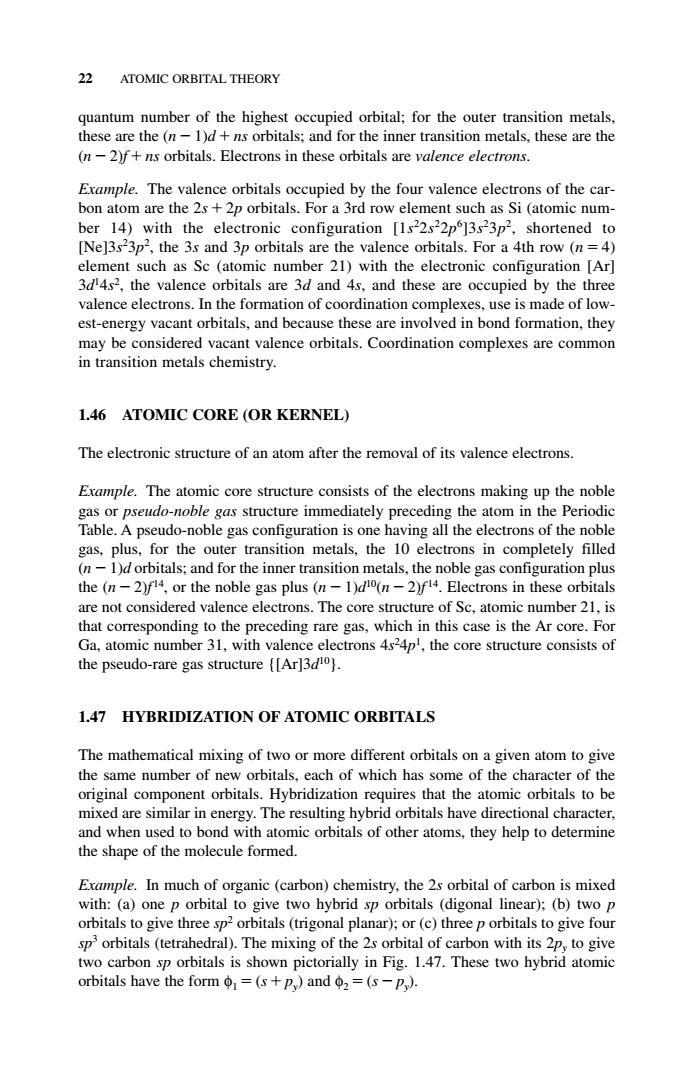正在加载图片...

22 ATOMIC ORBITAL THEORY quantum number of the highest occupied orbital;for the outer transition metals. these are the(n-1)d+ns orbitals;and for the inner transition metals,these are the (n-2)f+ns orbitals.Electrons in these orbitals are valence electrons. Example.The valence orbitals occupied by the four valence electrons of the car bon atom are the 2s+2p orbitals.For a 3rd row element such as Si (atomic num- ber 14)with the electronic configuration [1s22s22p5]3s23p2,shortened to [Ne]3s23p2,the 3s and 3p orbitals are the valence orbitals.For a 4th row (n=4) element such as sc (atomic number 21)with the electronic configuration larl 3d4s2,the valence orbitals are 3d and 4s,and these are occupied by the thre valence In the fo ion of coordinatio ade of low est-energy vacant orbitals,and because ese are invo ved in bo may be considered vacant valence orbitals.Coordination complexes are common in transition metals chemistry. 1.46 ATOMIC CORE (OR KERNEL) The electronic structure of an atom after the removal of its valence electrons. Example.The atomic core structure consists of the electrons making up the noble gas or pseudo-noble gas structure immediately preceding the atom in the Periodic Table.A seudo-noble gas configuration is one having all the electrons of the noble for the oute als the 10 electr sin completely filled itals;and for the inne transitio e gas co nguratio are not considered valence electrons.The core structure of Sc,atomic number 21,is that corresponding to the preceding rare gas,which in this case is the Ar core.For Ga,atomic number 31,with valence electrons 4s24p,the core structure consists of the pseudo-rare gas structure ([Ar]3d10). 1.47 HYBRIDIZATION OF ATOMIC ORBITALS The mathematical mixing of two or more different orbitals on a given atom to give the same number of new orbitals,each of which has some of the character of the nent orbitals.Hybridization s that the rbitals to b d are sim r in energy The re ybr rbita tional c and when use ed to bon with atomic orbi ls of other atoms,they help to determine the shape of the molecule formed. sporbitals(tetrahedral).The mixing of the 2s orbital of carbon with its 2p,to give two carbon sp orbitals is shown pictorially in Fig.1.47.These two hybrid atomic orbitals have the form=(s+p)and 2=(s-p). quantum number of the highest occupied orbital; for the outer transition metals, these are the (n 1)d ns orbitals; and for the inner transition metals, these are the (n 2)f ns orbitals. Electrons in these orbitals are valence electrons. Example. The valence orbitals occupied by the four valence electrons of the carbon atom are the 2s 2p orbitals. For a 3rd row element such as Si (atomic number 14) with the electronic configuration [1s22s22p6]3s23p2, shortened to [Ne]3s23p2, the 3s and 3p orbitals are the valence orbitals. For a 4th row (n 4) element such as Sc (atomic number 21) with the electronic configuration [Ar] 3d14s2, the valence orbitals are 3d and 4s, and these are occupied by the three valence electrons. In the formation of coordination complexes, use is made of lowest-energy vacant orbitals, and because these are involved in bond formation, they may be considered vacant valence orbitals. Coordination complexes are common in transition metals chemistry. 1.46 ATOMIC CORE (OR KERNEL) The electronic structure of an atom after the removal of its valence electrons. Example. The atomic core structure consists of the electrons making up the noble gas or pseudo-noble gas structure immediately preceding the atom in the Periodic Table. A pseudo-noble gas configuration is one having all the electrons of the noble gas, plus, for the outer transition metals, the 10 electrons in completely filled (n 1)d orbitals; and for the inner transition metals, the noble gas configuration plus the (n 2)f 14, or the noble gas plus (n 1)d10(n 2)f 14. Electrons in these orbitals are not considered valence electrons. The core structure of Sc, atomic number 21, is that corresponding to the preceding rare gas, which in this case is the Ar core. For Ga, atomic number 31, with valence electrons 4s2 4p1 , the core structure consists of the pseudo-rare gas structure {[Ar]3d10}. 1.47 HYBRIDIZATION OF ATOMIC ORBITALS The mathematical mixing of two or more different orbitals on a given atom to give the same number of new orbitals, each of which has some of the character of the original component orbitals. Hybridization requires that the atomic orbitals to be mixed are similar in energy. The resulting hybrid orbitals have directional character, and when used to bond with atomic orbitals of other atoms, they help to determine the shape of the molecule formed. Example. In much of organic (carbon) chemistry, the 2s orbital of carbon is mixed with: (a) one p orbital to give two hybrid sp orbitals (digonal linear); (b) two p orbitals to give three sp2 orbitals (trigonal planar); or (c) three p orbitals to give four sp3 orbitals (tetrahedral). The mixing of the 2s orbital of carbon with its 2py to give two carbon sp orbitals is shown pictorially in Fig. 1.47. These two hybrid atomic orbitals have the form φ1 (s py) and φ2 (s py). 22 ATOMIC ORBITAL THEORY c01.qxd 5/17/2005 5:12 PM Page 22�������